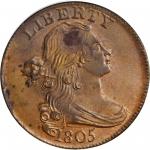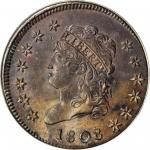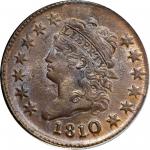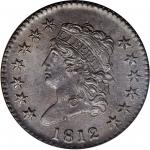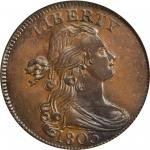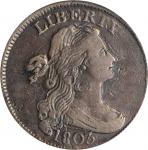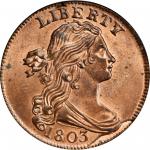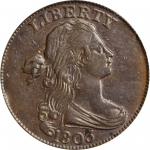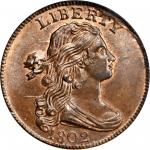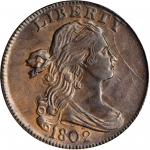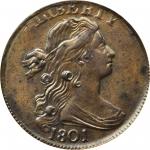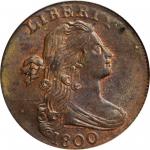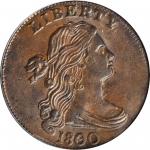1804 Draped Bust Cent. S-266, the only known dies. Rarity-2. EF-45 (PCGS).<strong>Type:</strong> Draped Bust.<p><strong>Design:</strong> Obv: A draped bust of Liberty faces right with the word LIBERTY above and the date 1804 below. Libertys hair is tied with a ribbon, the ends of which are plainly evident at the back of the head. Rev: A wreath surrounds the denomination ONE CENT, the base of the wreath bound by a ribbon tied into a bow. The legend UNITED STATES OF AMERICA is around the border and another expression of the denomination 1/100 is below.<p><strong>Weight Standard:</strong> 10.89 grams.<p><strong>Diameter:</strong> 29 mm.<p><strong>Die Variety:</strong> Sheldon-266, Breen-1. Obv: The only 1804-dated die in the regular issue Draped Bust cent series. The digit 1 is blunt, the 4 originally triple punched with the first two digits largely effaced, although traces of the repunching remain at the right base and crosslet of the primary 4. S-266 represents the only use of this obverse die. Rev: Large Fraction and Letters, the denominator set left with the numerator over the right side of the second digit 0. A long die line extends up to the right from the tip of the leaf next to the letter C in CENT. S-266 also represents the only use of this reverse die.<p>S-266 is the only die marriage known for the regular issue 1804 Draped Bust cent, the date therefore has only a single listing in the <em>Guide Book</em>.<p><strong>Die State:</strong> Noyes C/D, Breen IV. Obv: There is a heavy cud break at the border over the letters RTY in LIBERTY. Rev: Also with a prominent cud break at the border, in this case at the letters MERIC in AMERICA. This is the latest die state of the variety, traditionally known as S-266c.<p><strong>Edge:</strong> Plain.<p><strong>Mintage:</strong> The Mints report of 756,838 cents delivered during calendar year 1804 bears no relation to the actual number of coins struck from the only known 1804-dated die pairing. The actual mintage of this issue is unknown, but usually estimated at 96,500 pieces and derived from the final delivery of the year made on December 31. The remaining 660,338 cents delivered during calendar year 1804 were undoubtedly coined from 1803-dated dies.<p><strong>Estimated Surviving Population for the Die Variety:</strong> Rarity-2: 751 to 1,000 coins in all grades.<p><strong>Strike:</strong> An overall boldly defined example with plenty of sharp to full detail remaining to the finer elements of Libertys portrait and, to a lesser degree, the wreath. The obverse impression is generally well centered, although there is scant denticulation along the right border. The reverse impression is also well centered, the denticulation essentially full where allowed by the die state. The reverse is rotated approximately 30 degrees counterclockwise from normal coin alignment.<p><strong>Surfaces:</strong> Marbled toning of glossy deep olive-copper and lighter autumn-brown adorns both sides of this handsome piece. The latter color is dominant on the reverse, giving that side a somewhat lighter appearance than the obverse. There are ample remnants of a satiny finish and the surfaces are generally hard and tight. A trace of microgranularity is easily overlooked. Wispy handling marks are scattered about, most are inconspicuous to the unaided eye. A couple of tiny digs in the right obverse field before Libertys chin are useful identifiers.<p><strong>Commentary:</strong> Thanks to an abundant supply of planchets on hand (Breen says nearly 1,600,000, supplied by Matthew Boulton in England), the Mint was able to commence cent production early in 1804. By years end the Mint had delivered a total of 756,838 cents in six batches:<p>-March 31 = 160,000 coins<p>-June 26 = 224,500 coins<p>-June 30 = 84,000 coins<p>-September 29 = 1,500 coins<p>-November 12 = 190,338 coins<p>-December 31 = 96,500 coins<p>The scarcity of 1804-dated cents relative to most other issues in the Draped Bust series has led numismatists to theorize that most of the coins struck during calendar year 1804 were from 1803-dated dies. This is probably true, although the mintage of 96,500 coins for the 1804-dated issue provided in many numismatic references is also conjecture and based on Breens assumption that the final delivery of the year -- on December 31 -- represents the Mints only delivery from the 1804-dated die pairing. There is no documentary evidence to support this mintage and, indeed, it is listed in italics in the <em>Guide Book</em> to denote that it is an estimate. Some or all 1804-dated cents may have even been struck during calendar year 1805, and possibly even in 1806.<p>Cents of 1804 have long been famous, and perceptions of the issues rarity date to the 1840s, if not earlier. In 1841 James Morris, a storekeeper in Morgantown, Pennsylvania, recorded that he had "put away...a collection of cents beginning at 1793 and from thence to 1841 inclusive excepting only those of 1804 and 1815." Morris did not know that no such thing as an 1815 cent existed. For as rarely as they came over his store counter, 1804 cents might as well have not existed either, despite the fact that his business was located only 40 or so miles west of the Mint in Philadelphia. Morris was both a coin collector and an avid diarist. Though his numismatic activities have attracted little attention, Morris diary is famous for one reason: it records the first observance of Groundhog Day known in the United States.<p>By the late 1850s, when numismatics in the United States experienced its first great surge in popularity, the perceived rarity of the 1804 cent had become so entrenched that a privately produced "restrike" was made to satisfy collector demand. The dies that produced this so-called "restrike" were initially used at the Philadelphia Mint to produce the obverse of 1803 Sheldon-261 and the reverse of 1820 Newcomb-12. They were found on the location of the First Philadelphia Mint "among general rubbish when the basement was cleaned" years after the Mints 1833 departure from the site, probably in the mid 1850s according to a recollection published in the December 1910 issue of <em>The Numismatist</em>. These "restrikes," attributed as Breen-1761 in the authors <em>Encyclopedia</em>, were struck privately ca. 1860, are not products of the United States Mint, and bear no relation to the regular issue 1804 cent. They remain popular, nonetheless, and are avidly collected today alongside the Draped Bust cent series.<p>Interest in the regular issue 1804 cent continued to grow throughout the late 19th century and, by the 1880s, numismatists had confirmed that the single die marriage of the issue came in three die states. That discovery is credited to David U. Proskey in the January 1881 installment of his "Coins of the United States" in <em>The Coin Collectors Journal</em>, the house organ of Scott Stamp and Coin Company. Proskey, considered the most knowledgeable cent specialist of his generation, correctly noted, "The pair of dies just described were new and the only dies from which cents were struck during 1804, and owing to both breaking, they were not used in any succeeding year." The familiar nomenclature attached to the die states of 1804 cents -- Sheldon-266a, 266b, 266c -- was introduced later, however, specifically in Charles McGirks large cent attribution guide, published serially in <em>The Numismatist</em> in 1913 and 1914. McGirks system forced collectors to measure spatial relationships and then check them against a columnar chart, dooming it to failure from the start. Perhaps the only relic of McGirks system is the aforementioned description of 1804 cents as S-266a, 266b, or 266c. McGirk 1804 1A was the unbroken early die state, 1804 1B represented the scarce state with an obverse die break but no reverse die break, and 1804 1C referred to the state with breaks on both sides.<p>The fame and popularity of the 1804 cent continues the grow in the modern numismatic market, where it is firmly entrenched as a key date Draped Bust cent. At least part of the appeal of the 1804 cent stems from its association by date with some other key date issues from the early United States Mint, including both <em>Guide Book</em> varieties of the 1804 dime, the 1804 quarter and, most famously, the "King of American Coins," the 1804-dated dollar. Although much more is known about the 1804 cent today than when James Morris made his diary entry in 1841, the rarity is still sometimes exaggerated by overzealous catalogers and other numismatic writers. With upward of 1,000 coins extant in all grades, Sheldon-266 is not a rare die marriage in an absolute sense. Since it is the only one known for the date, however, an extant population of 1,000 coins or so confirms the scarcity of the 1804, especially when compared to most others in the Draped Bust cent series.<p>On the other hand, the condition rarity of the 1804 cent can hardly be overstated. Only a single Mint State coin is known, the fabulous PCGS MS-63 BN that most recently sold for $540,500 as lot 5121 in our April 2017 Pogue V Sale. The remaining 17 coins in the 2015 Noyes census range in EAC grade from AU50 to VF30. The present example is not included therein, seemingly overlooked since it retains far more detail and has much nicer surfaces than the vast majority of 1804 cents extant. A find for the advanced collector, and destined for another impressive large cent cabinet.PCGS# 1504.PCGS Population: 7; 9 finer, one of which is Mint State (MS-63 BN). The MS-62 BN listed at PCGS represents an earlier submission of the MS-63 BN coin.From the ESM Collection. Earlier from our (Stacks) Samuel J. Berngard Collection and Treasure Coins of the S.S. New York Sale, July 2008, lot 1107.

